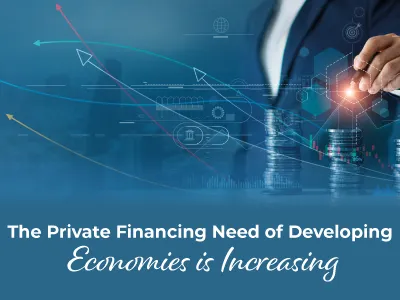
The Private Financing Need of Developing Economies is Increasing
A broad mix of policies is needed to unlock private capital and create a positive climate impact in emerging markets and developing economies. Therefore, a transition to net zero emissions must be achieved by 2050, and significant climate mitigation investments must be made in developing markets and economies that currently emit approximately two-thirds of greenhouse gases.
According to the International Energy Agency, these countries will need approximately $2 trillion a year by 2030 to achieve the target, and most of this financing will flow to the energy sector. This represents a fivefold increase from the current $400 billion climate investment planned over the next seven years. It is also anticipated that growth in public investments will be limited. Therefore, the private sector must contribute much more to the significant climate investment needs of emerging markets and developing economies. While the private sector should provide approximately 80 percent of the required investment, as pointed out in the analytical section of the latest Global Financial Stability Report, this share will increase to 90 percent, excluding China.

While China and other major developing economies have the necessary domestic financial resources, many other countries need developed financial markets that could provide large amounts of private financing. Moreover, it faces many obstacles to attracting international investors. That's because most prominent emerging market economies and nearly all developing countries lack the investment-grade credit ratings that institutional investors often require.

Meanwhile, while a growing number of investment funds prioritize sustainability, this has little impact on how much money is available for significant climate needs. Because only a small portion of such funds have explicitly aimed at creating a positive climate impact. Of course, many funds that make investment decisions based on environmental, social, and corporate governance factors do not necessarily focus on climate issues. However, they often consider ESG (Environmental, Social, Governance) scores in their portfolio allocations. Still, these are not designed to reflect climate impact, as shown in the latest Global Financial Stability Report.

Political Focus
Policies need to refocus on creating climate impact rather than supporting already “green” activities and consider the specific needs of emerging markets and developing economies. For example, transition classifications should consider activities with the potential for significant improvements in emissions over time and across sectors, including the most carbon-intensive areas such as steel, cement, chemicals, and heavy transport because emission reduction targets and criteria in transition classifications enable a country to achieve nationally determined interests, long-term strategies, and decarbonization targets for specific industries.
Today, sustainability labels are still very loose, and regulators and regulators need to establish clear rules and tighten enforcement. It is also essential that descriptions and labels on sustainable investment funds effectively improve market transparency and market integrity and comply with climate targets.
Of course, many of the policies suggested here will take time to be implemented and achieve their intended effects. Meanwhile, broader public-private risk sharing is critical to encouraging climate-private investment in emerging markets and economies. Multilateral development banks and donors are essential in supporting blended financing, including the broader use of guarantees.
 Back
Back







